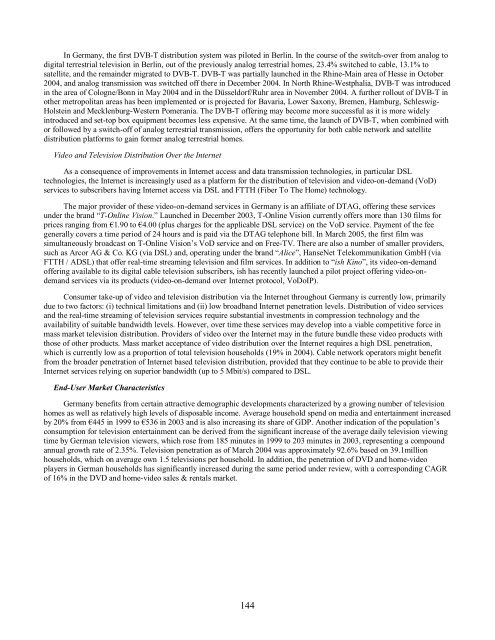iesy Repository GmbH - Irish Stock Exchange
iesy Repository GmbH - Irish Stock Exchange
iesy Repository GmbH - Irish Stock Exchange
Create successful ePaper yourself
Turn your PDF publications into a flip-book with our unique Google optimized e-Paper software.
In Germany, the first DVB-T distribution system was piloted in Berlin. In the course of the switch-over from analog to<br />
digital terrestrial television in Berlin, out of the previously analog terrestrial homes, 23.4% switched to cable, 13.1% to<br />
satellite, and the remainder migrated to DVB-T. DVB-T was partially launched in the Rhine-Main area of Hesse in October<br />
2004, and analog transmission was switched off there in December 2004. In North Rhine-Westphalia, DVB-T was introduced<br />
in the area of Cologne/Bonn in May 2004 and in the Düsseldorf/Ruhr area in November 2004. A further rollout of DVB-T in<br />
other metropolitan areas has been implemented or is projected for Bavaria, Lower Saxony, Bremen, Hamburg, Schleswig-<br />
Holstein and Mecklenburg-Western Pomerania. The DVB-T offering may become more successful as it is more widely<br />
introduced and set-top box equipment becomes less expensive. At the same time, the launch of DVB-T, when combined with<br />
or followed by a switch-off of analog terrestrial transmission, offers the opportunity for both cable network and satellite<br />
distribution platforms to gain former analog terrestrial homes.<br />
Video and Television Distribution Over the Internet<br />
As a consequence of improvements in Internet access and data transmission technologies, in particular DSL<br />
technologies, the Internet is increasingly used as a platform for the distribution of television and video-on-demand (VoD)<br />
services to subscribers having Internet access via DSL and FTTH (Fiber To The Home) technology.<br />
The major provider of these video-on-demand services in Germany is an affiliate of DTAG, offering these services<br />
under the brand “T-Online Vision.” Launched in December 2003, T-Online Vision currently offers more than 130 films for<br />
prices ranging from €1.90 to €4.00 (plus charges for the applicable DSL service) on the VoD service. Payment of the fee<br />
generally covers a time period of 24 hours and is paid via the DTAG telephone bill. In March 2005, the first film was<br />
simultaneously broadcast on T-Online Vision’s VoD service and on Free-TV. There are also a number of smaller providers,<br />
such as Arcor AG & Co. KG (via DSL) and, operating under the brand “Alice”, HanseNet Telekommunikation <strong>GmbH</strong> (via<br />
FTTH / ADSL) that offer real-time streaming television and film services. In addition to “ish Kino”, its video-on-demand<br />
offering available to its digital cable television subscribers, ish has recently launched a pilot project offering video-ondemand<br />
services via its products (video-on-demand over Internet protocol, VoDoIP).<br />
Consumer take-up of video and television distribution via the Internet throughout Germany is currently low, primarily<br />
due to two factors: (i) technical limitations and (ii) low broadband Internet penetration levels. Distribution of video services<br />
and the real-time streaming of television services require substantial investments in compression technology and the<br />
availability of suitable bandwidth levels. However, over time these services may develop into a viable competitive force in<br />
mass market television distribution. Providers of video over the Internet may in the future bundle these video products with<br />
those of other products. Mass market acceptance of video distribution over the Internet requires a high DSL penetration,<br />
which is currently low as a proportion of total television households (19% in 2004). Cable network operators might benefit<br />
from the broader penetration of Internet based television distribution, provided that they continue to be able to provide their<br />
Internet services relying on superior bandwidth (up to 5 Mbit/s) compared to DSL.<br />
End-User Market Characteristics<br />
Germany benefits from certain attractive demographic developments characterized by a growing number of television<br />
homes as well as relatively high levels of disposable income. Average household spend on media and entertainment increased<br />
by 20% from €445 in 1999 to €536 in 2003 and is also increasing its share of GDP. Another indication of the population’s<br />
consumption for television entertainment can be derived from the significant increase of the average daily television viewing<br />
time by German television viewers, which rose from 185 minutes in 1999 to 203 minutes in 2003, representing a compound<br />
annual growth rate of 2.35%. Television penetration as of March 2004 was approximately 92.6% based on 39.1million<br />
households, which on average own 1.5 televisions per household. In addition, the penetration of DVD and home-video<br />
players in German households has significantly increased during the same period under review, with a corresponding CAGR<br />
of 16% in the DVD and home-video sales & rentals market.<br />
144

















